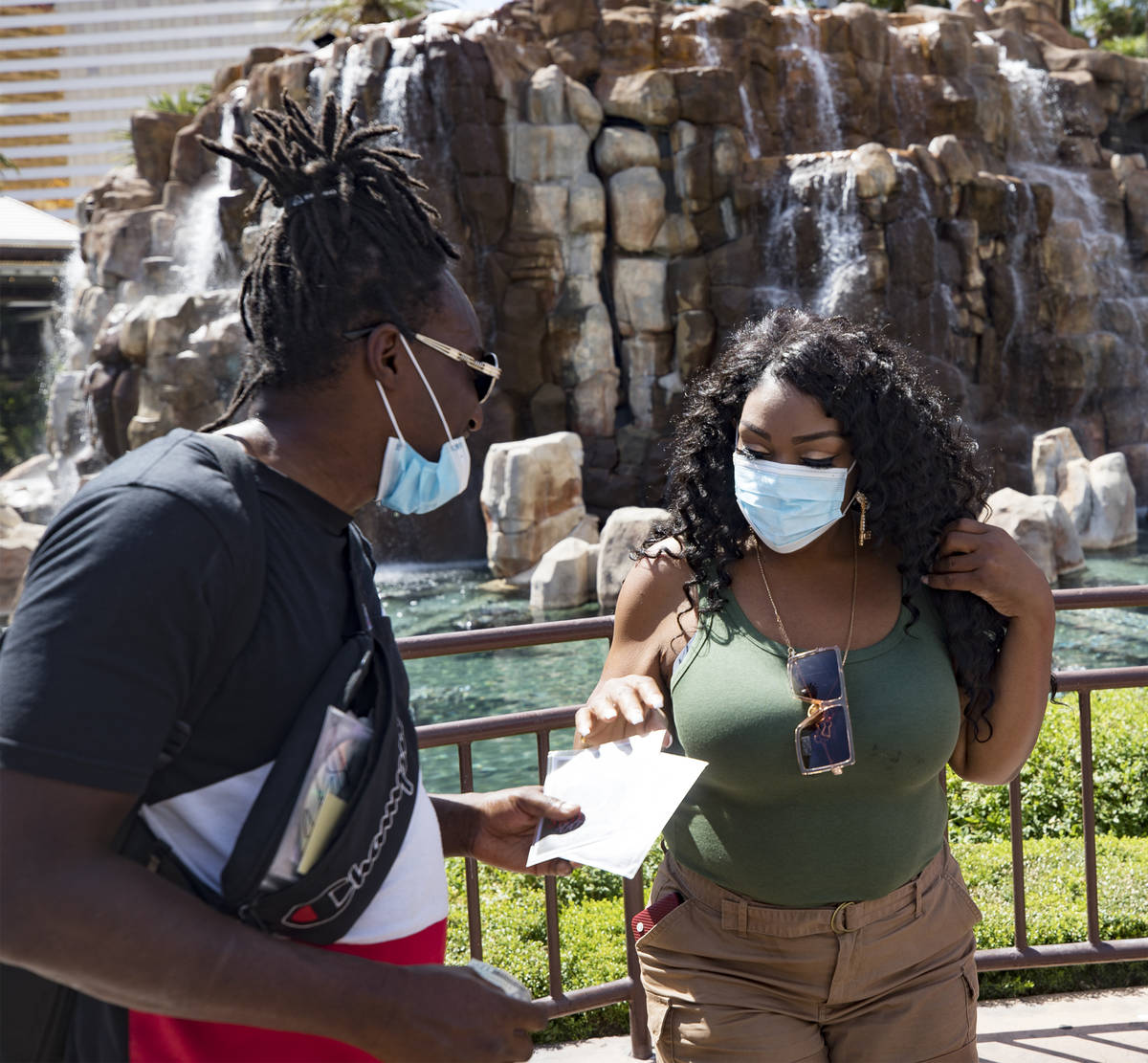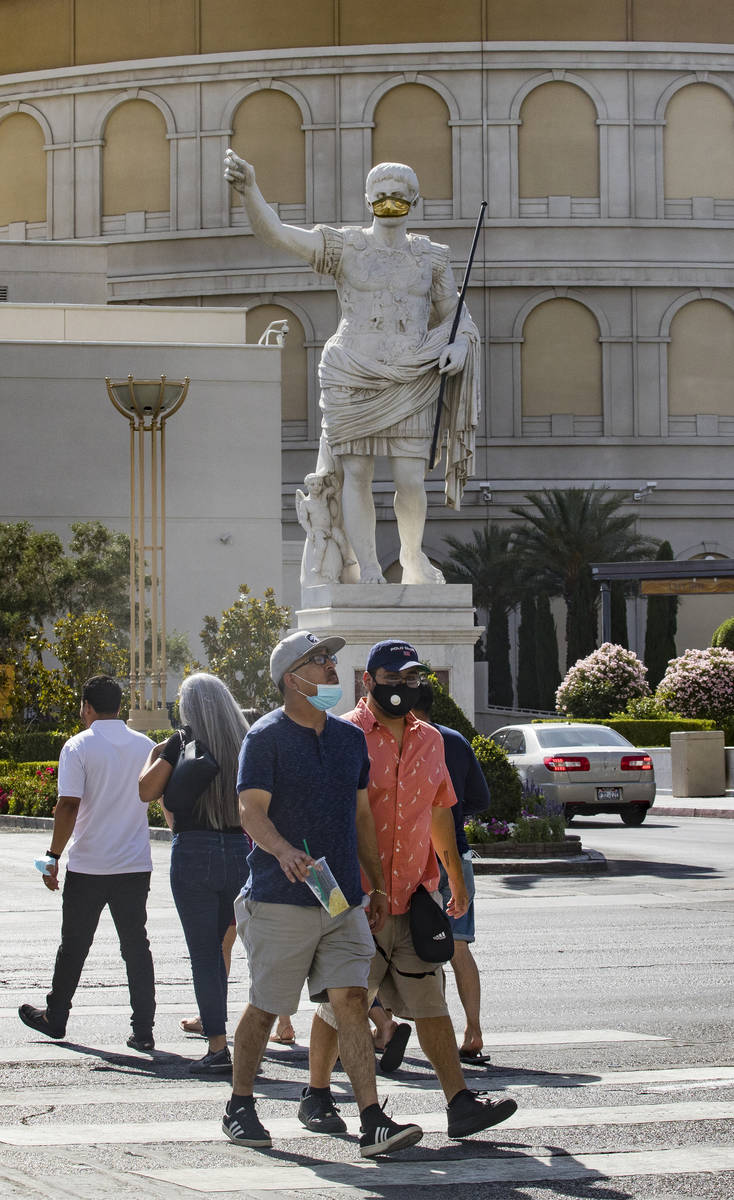Guidance from agencies on mask-wearing not cut-and-dried
As divisive as any question in today’s polarized climate is one that sounds so simple: Should everyone be wearing a mask in public to curb the spread of the coronavirus?
Those who support wearing a mask cite recommendations from public health officials as well as common sense. Who, after all, wants to be sneezed on? Those who don’t favor universal mask-wearing note that recommendations have been confusing and inconsistent. They question whether cloth masks offer much benefit beyond making the wearer feel smug.
Although many people come down strongly on one side or another, neither the science nor the guidance on masks is so clear-cut. The debate has raged on in recent days as Gov. Steve Sisolak asked members of his medical advisory team Friday to evaluate whether the public should be required to wear masks in public, as is now the case in California.

In Nevada, the state requires masks in many work settings, including restaurants, offices and stores, and for all employees who interact with the public. But the state doesn’t require them for customers, with one exception: The Gaming Control Board on Wednesday mandated that gamblers playing table games wear masks.
Otherwise, state and county officials have strongly encouraged, but not compelled, the public to wear masks.
“We support and follow the recommendations of the Centers for Disease Control and Prevention and World Health Organization,” said Jennifer Sizemore, a spokeswoman for the Southern Nevada Health District. “The recommendation is for the public to wear cloth face coverings.”
Yet even the CDC and WHO, top U.S. and international public health agencies, respectively, don’t fully see eye-to-eye on when the public should be wearing masks.
World Health Organization
WHO, an agency of the United Nations responsible for international public health, on June 5 issued new guidance regarding masks.
The updated guidance states in part, “Many countries have recommended the use of fabric masks/face coverings for the general public. At the present time, the widespread use of masks by healthy people in the community setting is not yet supported by high quality or direct scientific evidence and there are potential benefits and harms to consider.”
But taking into account studies of transmission of the coronavirus by infected people without symptoms, as well as “observational evidence” on the use of masks by the public in several countries, WHO now advises that in areas where the virus is spreading, “governments should encourage the general public to wear masks in specific situations and settings as part of a comprehensive approach to suppress SARS-CoV-2 (novel coronavirus) transmission.”
A statement from WHO in response to questions from the Review-Journal laid out these specific situations.
In areas where the virus is spreading, people age 60 years or over, or those with underlying conditions, should wear a surgical mask “in situations where physical distancing is not possible,” the statement said.
Governments should encourage the public to wear cloth masks where there is widespread transmission and physical distancing is difficult, such as on public transportation, in stores or in “other confined or crowded environments,” the statement said.
In its updated guidance, the international organization lists both pros and cons of mask-wearing. It states that the likely advantages of the use of masks by healthy people include reduced potential risk from infected persons before they develop symptoms and “reduced potential stigmatization of individuals wearing masks to prevent infecting others.”
Disadvantages include “potential increased risk of self-contamination due to the manipulation of a face mask and subsequently touching eyes with contaminated hands” and ”potential self-contamination that can occur if nonmedical masks are not changed when wet or soiled,” creating “favorable conditions for microorganism to amplify.”
The updated guidance stems in part from a WHO-funded review of data from 172 observation studies, published in the Lancet medical journal this month, which found that wearing masks can reduce the risk of coronavirus infection. The finding came with the caveat that it had a “low level of certainty,” in part because there have yet to be randomized, controlled trials of mask effectiveness.
Centers for Disease Control and Prevention
As for the CDC, it recommends that people age 2 and older wear cloth masks “in public settings where other social distancing measures are difficult to maintain.”
The CDC emphasizes that wearing cloth masks primarily will protect people with whom the wearer comes into contact.
“Infected people can spread the virus before they develop symptoms, and cloth face coverings provide what we call ‘source control’ to reduce spread from the wearer’s coughs or exhaled breath,” Kristin Nordlund, a spokeswoman for the CDC, said in an email.
At the start of the pandemic, the CDC said there was no need for healthy members of the public to wear masks. It also advised that surgical masks and heavier-duty N95 masks were in short supply around the globe and should be reserved for medical personnel.
But as some evidence began to show that the disease could be spread by people infected by the virus who either never developed symptoms or before they were symptomatic, CDC changed course and recommended that the public wear cloth masks to avoid infecting others.
“Data are limited on the effectiveness of cloth face coverings in this respect and come primarily from laboratory studies,” Nordlund said. “We know that future studies are needed that measure the filtering efficiency and extent to which face coverings reduce SARS-CoV-2 transmission from someone who is infected, especially those who are asymptomatic or pre-symptomatic.”
Brian Labus, a member of the governor’s medical advisory team, said there can be no waiting for future studies.
“That’s evidence we’d love to have. But it takes time to do those studies,” said Labus, an assistant in UNLV’s School of Public Health. “In the meantime, we’re still dealing with an outbreak.”
Wearing a mask is a basic way to prevent disease transmission, he said: “We’re doing it for the same reason you cover your mouth when you cough or sneeze.”
Labus would like to see masks mandated for the public. But meanwhile, “I’m not wearing this stupid mask for me. I’m wearing it for you,” he said. “If I’m infected right now and I don’t know it, and I can put this mask on to keep you from getting sick, I’m going to do it.”
Contact Mary Hynes at mhynes @reviewjournal.com or 702-383-0336. Follow @MaryHynes1 on Twitter.



















































